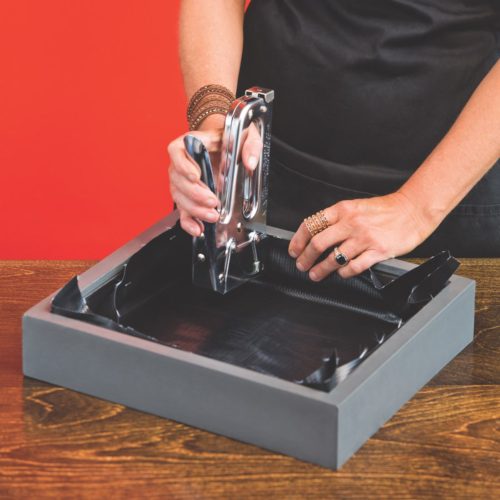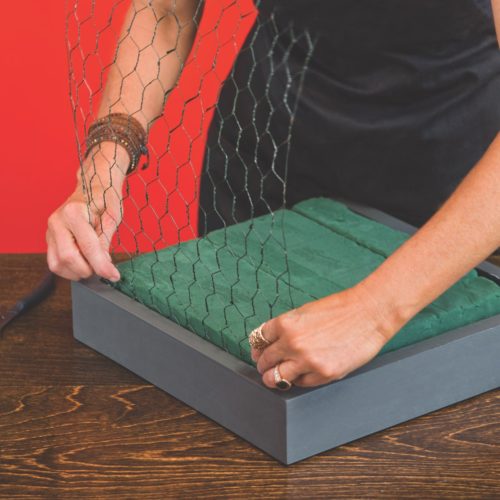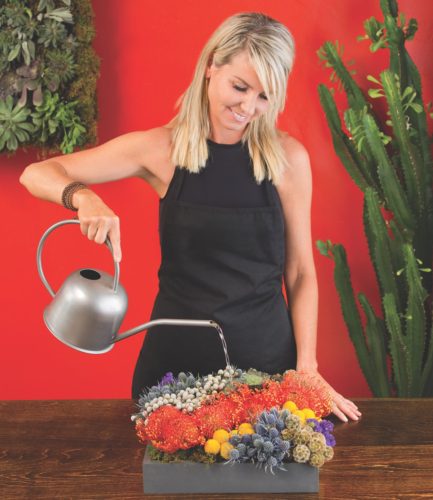
Colleen LaFleur of Atelier de LaFleur shows how to make an eco-friendly, desert inspired centerpiece that can anchor a runner of succulents, cacti and flowers.
My inspiration for this design was the desert landscape in Tucson. Here we have an extended period of warm weather to enjoy outdoor entertaining, so I created an eco-friendly table runner for my patio that I could enjoy all summer long. Using shadow boxes as containers, I planted four living squares and arranged one cut-flower square that will dry beautifully. They were carefully designed using color and texture to create a curvilinear line that is picked up by the next square when placed in row. This five-piece table runner will last several months—maybe even years—with very little upkeep. Each living square has six or seven varieties of succulents, aloe, or cacti planted with soil, but here I’m demonstrating how to create the cut-flower square using floral foam, which keeps the flowers temporarily fresh before they dry.

Materials
- eryngium
- silver brunia
- lotus pods
- pincushion protea
- statice
- craspedia
- scabiosa pods
- moss

Tools & Supplies
- 12” square shadow box
- three bricks of floral foam
- watering can
- floral chicken wire
- 45-mil pond liner
- staple gun
- floral knife
- hammer
- wire cutters
- floral shears
- bamboo floral stake
- gloves

1| Begin by removing the backing of the shadow box. Then cut a square (about 15”) of the pond liner, which will replace the backing.

2| Staple-gun the pond liner to the inside of the shadow box, which will retain the water from the wet floral foam. (When planting the living squares of aloe, cacti, and succulents, puncture the liner to create drain holes.)

3| After soaking the bricks of floral foam in water, place them in the lined box. The first two will fit, but the third needs to be cut to fill in the extra space. Then, cut a piece of chicken wire about a half inch larger than the box. Gently wrap it over the wet foam and tuck in the ends. (For the living squares, you can place the chicken wire over the soil like we’ve done here with the foam.)

4| Cut a protea stem and insert it into the foam to begin the square’s curvilinear line. Place it accordingly so that it follows the line in the adjacent living square, creating one continuous pattern.

5| Once you’ve made the line of protea, start another grouping, such as the lotus pods. If a stem is too flimsy to insert, use the bamboo floral stake to push it into the foam. (This is also useful for succulents with shallow root systems and cacti with prickly needles.)

6| Continue adding other materials, such as the silver brunia, in a flat, tight pattern. While doing this, line up the squares so you can create a nice mix of color and texture from square to square. This will help achieve the look of a long, cohesive table runner.
7| Repeat with the eryngium, craspedia, statice, and scabiosa pods, grouping each type closely together to cover the floral foam (or soil). If a little is showing after you place the last flower, fill in with some moss.

8| Maintaining the runner is easy. This square can be watered to prolong its fresh look, but it will also dry beautifully. (Water the living squares as you would your other outdoor patio plants.)
“The desert has taught me to be more responsible with my designs, choosing plants and flowers that are drought tolerant, sustainable, and beautiful. I like to think of my design aesthetic as eco-chic.” –Colleen LaFleur
By Colleen LaFleur
Produced by Abby Braswell
Photography by Natasha Mishano






